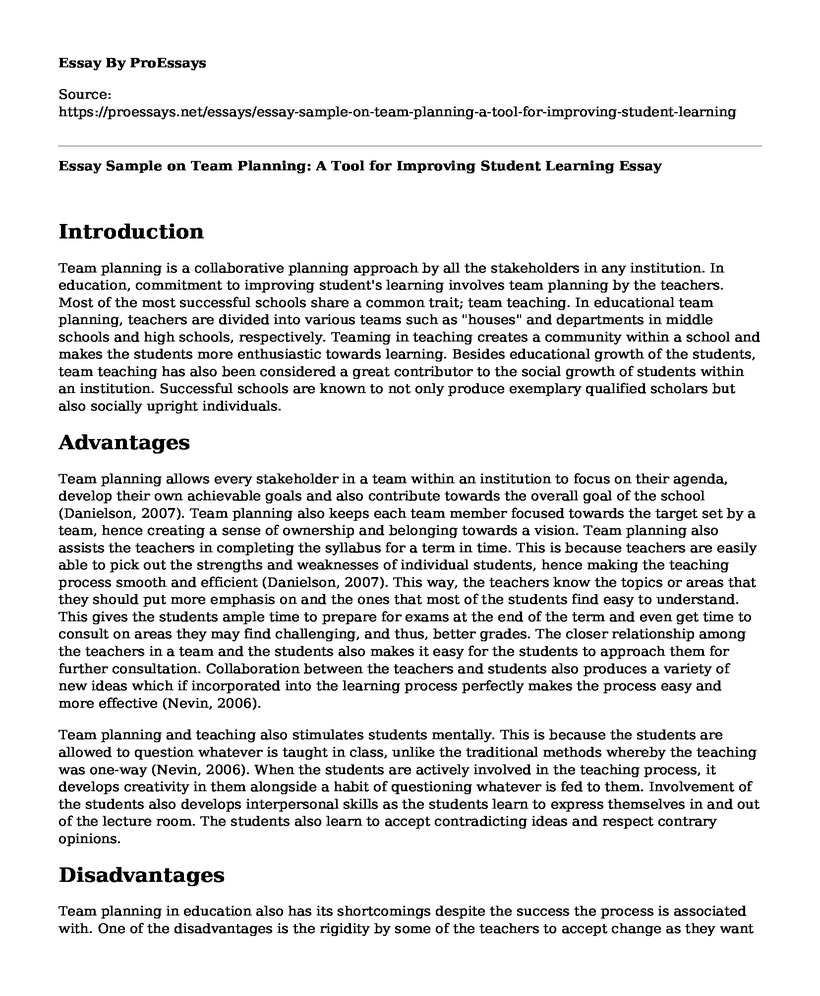Introduction
Team planning is a collaborative planning approach by all the stakeholders in any institution. In education, commitment to improving student's learning involves team planning by the teachers. Most of the most successful schools share a common trait; team teaching. In educational team planning, teachers are divided into various teams such as "houses" and departments in middle schools and high schools, respectively. Teaming in teaching creates a community within a school and makes the students more enthusiastic towards learning. Besides educational growth of the students, team teaching has also been considered a great contributor to the social growth of students within an institution. Successful schools are known to not only produce exemplary qualified scholars but also socially upright individuals.
Advantages
Team planning allows every stakeholder in a team within an institution to focus on their agenda, develop their own achievable goals and also contribute towards the overall goal of the school (Danielson, 2007). Team planning also keeps each team member focused towards the target set by a team, hence creating a sense of ownership and belonging towards a vision. Team planning also assists the teachers in completing the syllabus for a term in time. This is because teachers are easily able to pick out the strengths and weaknesses of individual students, hence making the teaching process smooth and efficient (Danielson, 2007). This way, the teachers know the topics or areas that they should put more emphasis on and the ones that most of the students find easy to understand. This gives the students ample time to prepare for exams at the end of the term and even get time to consult on areas they may find challenging, and thus, better grades. The closer relationship among the teachers in a team and the students also makes it easy for the students to approach them for further consultation. Collaboration between the teachers and students also produces a variety of new ideas which if incorporated into the learning process perfectly makes the process easy and more effective (Nevin, 2006).
Team planning and teaching also stimulates students mentally. This is because the students are allowed to question whatever is taught in class, unlike the traditional methods whereby the teaching was one-way (Nevin, 2006). When the students are actively involved in the teaching process, it develops creativity in them alongside a habit of questioning whatever is fed to them. Involvement of the students also develops interpersonal skills as the students learn to express themselves in and out of the lecture room. The students also learn to accept contradicting ideas and respect contrary opinions.
Disadvantages
Team planning in education also has its shortcomings despite the success the process is associated with. One of the disadvantages is the rigidity by some of the teachers to accept change as they want to stick to the traditional one-way teaching method. Others include; bad team management, personal conflicts among team members, resistance from students, among others.
Seeing the many benefits of team planning in education, I would definitely like to be involved in team planning in my career. This is because the process will give me a chance to know the individual students' strengths and weaknesses and thus make the teaching process much effective.
Syllabus Design for Effective Planning as a Teacher
Beyond the syllabus content, procedures, and requirements for a particular course, one as a teacher ought to understand the kind of students they are dealing with for that particular course. The teacher has to know the student's motivation towards taking a particular course as well as their background prior to enrolling for the course (Doolittle, 2010). The teacher should also seek to know the students' abilities in order to handle the course effectively. The teacher should also be able to set goals for the students on what they should accomplish by the end of the course. Without considering the students taking a particular course, syllabus design will, therefore, be incomplete.
References
Danielson, C. (2007). Enhancing professional practice: A framework for teaching. Princeton, N.J: Recording for the Blind & Dyslexic.
Doolittle, Peter & Siudzinski, Robert. (2010). Recommended Syllabus Components: What Do Higher Education Faculty Include in their Syllabi?. Journal on Excellence in College Teaching. 20. 29-61.
Nevin, A. (2006). The Many Faces of Collaborative Planning and Teaching. Theory Into Practice. 45. 239.
Cite this page
Essay Sample on Team Planning: A Tool for Improving Student Learning. (2023, Feb 12). Retrieved from https://proessays.net/essays/essay-sample-on-team-planning-a-tool-for-improving-student-learning
If you are the original author of this essay and no longer wish to have it published on the ProEssays website, please click below to request its removal:
- The Notion of Truth Values in Semantics
- Management Information Systems Essay
- How a Nurse Leader Helps a Nurse Colleague Pursue Their Professional Goals Essay
- Paper Example on Chaining to Teach a Functional Self-Help Skill to a Child With Autism
- Journal Report: Specific Ideas Gained About Leadership Paper Example
- Sustainable Forest Management Leadership: British Columbia (B.C.) Leading the Way - Essay Sample
- Essay Example on Being an Instructor: Challenges & Rewards







